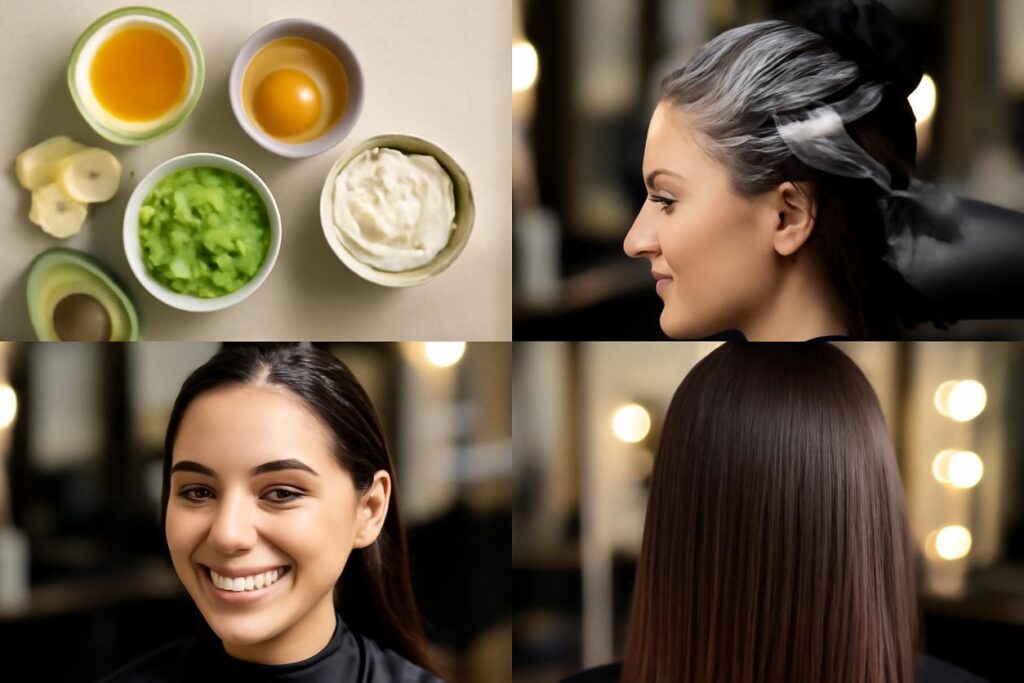The Ultimate Guide to Overnight Hair Care: Wake Up to Flawless Hair in 2025
Table of Contents
- Why night-time routines reshape morning hair
- How to assess your hair texture and overnight needs
- Gentle pre-sleep prep
- Moisture and seal methods by hair type
- Protective styles and pillowcase choices
- Overnight treatments you can make at home
- Quick morning rescue tactics for rested-looking hair
- Materials and tools that reduce friction and breakage
- Common overnight mistakes to avoid
- Simple 7-night plan and printable checklist
- Evidence summary and further reading
Imagine waking up, looking in the mirror, and seeing hair that’s already smooth, defined, and ready for the day. No more wrestling with frizz, tangles, or limp locks. This isn’t a far-fetched dream; it’s the achievable result of a consistent overnight hair care routine. While you sleep, your body is in a state of repair, and with a few simple steps, your hair can reap those benefits too. This guide will walk you through low-effort, high-impact strategies to transform your hair while you rest, making your mornings easier and your strands healthier.
Why night-time routines reshape morning hair
You might think your hair is just passively lying there while you sleep, but the eight hours you spend in bed can either be a source of damage or a golden opportunity for restoration. The magic of overnight hair care lies in leveraging this extended period for uninterrupted treatment and protection.
At a microscopic level, your hair is covered in tiny, overlapping scales called cuticles. When these cuticles are rough and raised, your hair feels frizzy and appears dull. During the night, a proper routine can help these cuticles lie flat. This is achieved through two primary mechanisms:
- Moisture Retention: While you sleep, your hair can absorb and lock in moisture from leave-in conditioners or oils without interruption from environmental factors like sun and wind. This deep hydration helps to smooth the cuticle, leading to softer, shinier hair by morning.
- Friction Reduction: Tossing and turning on a standard cotton pillowcase creates significant friction. This friction snags the hair cuticle, leading to breakage, split ends, and tangles. A strategic overnight hair care plan minimizes this friction, preserving your hair’s integrity.
By investing just five minutes before bed, you are essentially setting your hair up for success. You’re preventing damage before it starts and giving your hair the uninterrupted time it needs to absorb nutrients and repair itself.
How to assess your hair texture and overnight needs
Before you can build an effective routine, you need to understand your hair’s unique properties. The two most important factors are texture (the thickness of individual strands) and porosity (the hair’s ability to absorb and retain moisture). A successful overnight hair care strategy is always tailored to these needs.
To assess your texture:
- Fine Hair: A single strand is difficult to see or feel between your fingertips. Fine hair is prone to getting weighed down by heavy products.
- Medium Hair: You can feel a single strand between your fingers, and it feels neither fine nor rough. This is the most common texture.
- Coarse Hair: A single strand feels thick and strong. Coarse hair is often more resistant to chemical treatments and can feel dry or wiry if not properly moisturized.
To assess your porosity:
A simple way to check is the water spray test. On clean, product-free hair, spritz a small section with water.
- Low Porosity: Water beads up on the hair shaft and takes a while to absorb. This hair type is moisture-resistant, and products can sit on top rather than sinking in.
- Normal Porosity: Water absorbs into the hair after a minute or two. This hair has a healthy balance of moisture retention.
- High Porosity: Water absorbs almost instantly, like a sponge. This hair type can lose moisture just as quickly as it absorbs it, often feeling dry and prone to frizz.
Once you know your hair type, you can choose the right products and techniques for your overnight hair care regimen.
Gentle pre-sleep prep
How you prepare your hair for bed is just as important as the treatments you use. The goal is to minimize stress on the strands and create a clean slate for your overnight products.
Detangling without damage
Never go to bed with tangled hair, as this will only worsen overnight. However, aggressive brushing can cause severe breakage. Follow this gentle method:
- Start at the ends: Always begin detangling from the tips of your hair and slowly work your way up to the roots. This prevents you from pushing small knots into one large, unmanageable one.
- Use the right tool: A wide-tooth comb or your fingers are the best options for detangling, especially on wet or damp hair. A brush is often too harsh.
- Work in sections: Divide your hair into four or more sections to make the process more manageable and ensure every strand is addressed.
When to wash before bed
Washing your hair at night can be a great time-saver. However, sleeping on soaking wet hair is one of the biggest mistakes you can make. Hair is at its most fragile when wet because the protein bonds are temporarily weakened. The friction from your pillow can stretch these bonds to their breaking point.
If you wash your hair in the evening, allow it to air dry at least 80% of the way or use a diffuser on a low-heat, low-speed setting. Applying your overnight hair care products to damp, not sopping wet, hair is ideal for maximum absorption and safety.
Moisture and seal methods by hair type
The core of any great overnight hair care routine is hydration. This involves applying a moisturizing product (something water-based, like a leave-in conditioner) and then sealing that moisture in with an oil or cream. The type and amount of product depend entirely on your hair texture.
Fine to normal
For this hair type, the challenge is to moisturize without weighing the hair down. Less is more.
- Moisturizer: Use a lightweight, water-based leave-in spray or a very small, pea-sized amount of serum. Focus application from the mid-lengths to the ends, avoiding the roots.
- Sealant: A few drops of a dry, lightweight oil like grapeseed or jojoba oil is sufficient. Rub it between your palms first to warm it up and ensure even distribution.
Dry and coarse
This hair type is thirsty and can handle richer products to keep it soft and manageable.
- Moisturizer: A creamy leave-in conditioner is an excellent choice. Be more generous with the application, ensuring all strands are lightly coated.
- Sealant: Use a slightly heavier oil like argan or avocado oil. You can also use a hair butter, focusing on the ends, which are often the driest part of the hair.
Curly and coily
Curls and coils need maximum moisture to prevent frizz and maintain their pattern. The LOC (Liquid, Oil, Cream) or LCO (Liquid, Cream, Oil) methods are perfect for overnight hair care.
- Liquid: Start with a water-based leave-in conditioner or even just water in a spray bottle to hydrate the hair.
- Oil/Cream: Follow with a nourishing oil (like castor or olive oil) and a thick curl cream or butter to seal everything in. This multi-layer approach ensures moisture is locked in tight until morning.
Protective styles and pillowcase choices
Once your hair is prepped and moisturized, the final step is to protect it physically from friction and tangling. This two-pronged approach involves how you wear your hair and what surface it touches.
Braids and twists
A protective style is any hairstyle that keeps your ends tucked away and minimizes manipulation. For sleeping, these styles should always be loose to avoid tension on the scalp.
- The Loose Braid: A simple, single braid down the back is perfect for straight or wavy hair. It prevents tangles and can create soft waves by morning.
- The Pineapple: Ideal for curly and coily hair, this involves gathering your hair into a very high, loose ponytail on top of your head, secured with a gentle tie like a scrunchie. This protects the curl pattern.
- Twists or Buns: A loose bun on top of the head or several large, two-strand twists can also effectively reduce friction and tangling.
Silk and satin options
Your choice of fabric is a game-changer for overnight hair care. Cotton is highly absorbent and has a rough texture. It robs your hair of moisture and creates damaging friction.
- Pillowcases: Switching to a silk or satin pillowcase is one of the easiest and most effective changes you can make. The smooth surface allows your hair to glide across it, reducing breakage and preserving your style.
- Bonnets and Scarves: For an extra layer of protection, especially for curly and coily types, a satin-lined bonnet or a silk scarf is essential. These contain the hair completely, locking in moisture and eliminating all friction.
Overnight treatments you can make at home
You don’t need expensive products to give your hair a deep conditioning treatment. Simple, natural ingredients from your kitchen can provide excellent benefits as part of your overnight hair care plan.
Oil-based seals
Applying a small amount of a natural oil to your ends before bed can prevent split ends and add shine. After your leave-in conditioner, warm a few drops of one of these oils in your palms and smooth it over the bottom two to three inches of your hair.
- Jojoba Oil: Its molecular structure is very similar to the natural sebum your scalp produces, making it easily absorbed.
- Argan Oil: Rich in fatty acids and vitamin E, it’s a fantastic moisturizer for dry, brittle hair.
- Coconut Oil: It’s known for its ability to penetrate the hair shaft and reduce protein loss. Use sparingly, as it can be heavy for fine hair.
Protein balance masks
Hair is primarily made of a protein called keratin. Occasionally, it needs a protein boost to strengthen its structure. However, “protein overload” can make hair brittle, so use these treatments no more than once every few weeks. Never leave a heavy protein mask on overnight; instead, consider a lighter rinse before your usual prep.
A simple pre-bed protein rinse can be made with rice water. After washing your hair, pour the starchy water left over from rinsing rice through your hair, let it sit for 20 minutes, then rinse it out before applying your usual leave-in and sealant. This provides a gentle strengthening effect without the risk of overnight stiffness.
Quick morning rescue tactics for rested-looking hair
Even with the best overnight hair care, some mornings your hair might need a little encouragement. Here are some two-minute fixes:
- For Flatness: Flip your hair upside down and gently massage your roots with your fingertips to boost volume. A quick blast with a hairdryer on the cool setting can also help.
- For Frizz or Flyaways: Lightly mist your hair with water or a refreshing spray. Smooth down any errant hairs with the tiny amount of leftover leave-in conditioner or oil on your hands.
- For Curls That Need a Boost: Target any stretched-out or frizzy curls by spritzing them with water to reactivate the product from the night before, then gently scrunching.
Materials and tools that reduce friction and breakage
Investing in a few key items will elevate your overnight hair care routine and protect your hair in the long run.
- Silk or Satin Pillowcase: The number one tool for reducing friction.
- Satin-Lined Bonnet or Scarf: Essential for protecting curls and locking in moisture.
- Scrunchies: Use scrunchies made of silk, satin, or velvet. They are gentler on hair and prevent the dents and breakage caused by traditional elastic ties.
- Wide-Tooth Comb: Your go-to tool for gentle detangling, especially on damp hair.
- Microfiber Towel: If you wash your hair at night, use a microfiber towel or an old t-shirt to gently squeeze out excess water. The rough texture of a standard terrycloth towel can damage the hair cuticle.
Common overnight mistakes to avoid
Sometimes, what you *don’t* do is as important as what you do. Avoid these common pitfalls in your overnight hair care routine:
- Using Tight Hairstyles: A tight ponytail or bun puts constant tension on your hair follicles, which can lead to traction alopecia (hair loss). Always keep protective styles loose and comfortable.
- Sleeping on Wet Hair: As mentioned, hair is extremely fragile when wet. Always ensure it’s at least 80% dry before your head hits the pillow.
- Over-Applying Product: Using too much oil or cream can clog scalp pores and leave your hair looking greasy and weighed down. Start with a small amount and add more only if needed.
- Forgetting the Ends: The ends of your hair are the oldest and most fragile part. They need the most attention and moisture to prevent split ends.
Simple 7-night plan and printable checklist
Consistency is key. To help you get started, here is a sample weekly overnight hair care plan for 2025 that balances moisture and rest. You can adjust it based on your wash day schedule.
| Day | Nightly Routine Focus | Key Action |
|---|---|---|
| Monday (Wash Day) | Deep Moisture | Apply leave-in conditioner and seal with oil/cream on damp hair. Style in a loose braid/twists. |
| Tuesday | Refresh and Protect | Lightly mist hair with water if needed, apply a tiny bit of oil to ends, and secure in a pineapple or loose bun. |
| Wednesday | Moisture Maintenance | Assess dryness. Apply a small amount of leave-in conditioner to ends before putting hair up. |
| Thursday | Scalp Care | Gently massage your scalp for a few minutes before bed to stimulate blood flow. Protect hair as usual. |
| Friday | Light Refresh | Similar to Tuesday. Focus on simply protecting the hair in a loose style with a silk scrunchie. |
| Saturday | Prep for Wash Day | Optional: Apply a light pre-wash oil treatment to your hair and let it sit overnight. |
| Sunday | Rest Night | Simply put hair into a loose protective style on your silk pillowcase. Let your hair and scalp breathe. |
Evidence summary and further reading
An effective overnight hair care routine is one of the most powerful tools for achieving long-term hair health. By focusing on the core principles of moisture, friction reduction, and gentle handling, you can prevent damage before it happens and wake up with hair that is softer, shinier, and easier to manage. Remember to assess your hair’s unique texture and porosity to tailor a routine that works specifically for you. Consistency will transform your hair, turning your sleep into a truly beautifying experience.
For more in-depth advice on hair types and professional care, you can explore resources from hair experts. One such resource is Rich Hair UK, which offers further insights into hair health and styling.






